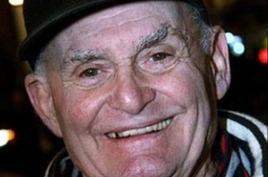Vanoush Khanamirian
Tuesday, April 28, 2020
Vanoush Gerasimich Khanamirian (November 5, 1927 – October 5, 2011) was an Armenian ballet, traditional and folkloric dance choreographer.
He first started as a ballet dancer, his first major performance was in the wedding scene of a famous Armenian ballet production "Anoush." He grew to love the art of dancing and began to play major solo parts in different ballet productions. Khanamirian became very famous, playing numerous ballet solos throughout the Asian continent and abroad. He was later appointed to be the Artistic Leader of the State Dance Ensemble of Armenia. For over twenty years Khanamirian led the Dance Ensemble of Armenia to be one of the best in the former Soviet Republic. Khanamirian managed to create and direct hundreds of different dances while he was the Artistic Leader, many of which are still being danced by dance groups around the world.
He joined the Alexander Spendiarian[1] Academic Theater of Opera and Ballet in 1941. In 1947, Khanamirian got his first major part as "Nerso" in Aram Khachaturyan's "Gayane" Ballet, and soon after that became one of the soloists in the Yerevan Opera Theater. Aram Khachaturyan was present at one of the concert; Khachaturyan was quoted as saying "The way Khanamirian danced made me realize how cultural and Armenian my music really is." Khanamirian became known in the Ballet Academy when he played the role of "Sasuntsi Davit," which he performed so well that a very famous Armenian sculptor at the time, Yervand Kochar, asked him to be the model for the statue of "David of Sasun," one of many famous statues in Yerevan, Armenia today. Khanamirian played in as many as twenty famous ballet productions like "Arshak," "Sevan," "Khantoot" and "Marmar", but he became famous for his role in "Spardak" Khanamirian also directed three ballet productions, two of which won national awards in Moscow.
In 1968 Khanamirian was invited to Armenia's National Cultural Administration and was offered the title of a National Artistic Director of the Armenian Dance Ensemble. He deserved to be called a national cultural art director, this was the opportunity he'd been waiting for. Khanamirian directed famous dances that symbolized thousands of years of Armenian heritage and culture, showing the real folk-lore as people's art. The capabilities of Vanoush Khanamirian as a choreographer and artistic leader were discovered with great force just in the staging of his dances, leaving such a strong impression on the audience, in spite of their seeming simplicity. Under his leadership, the Dance Ensemble of Armenia became one of the best groups in Armenia to represent Armenian cultural dance. The ensemble traveled to almost every continent around the world from the '70s to the '80s (11 states in America), sometimes doing sixty concerts in sixty days. Khanamirian lead the ensemble until his retirement in the early '90s.
He lived with his wife in Yerevan until October 2011. He was active in the art of dance until his last days. In 2001, Khanamirian was appointed to be in charge of the Union of Art of Dance Workers of Armenia, where he worked to preserve the purity of the national dances. The History of Armenian people has created a large Armenian diaspora around the world, and Armenian art has evolved accordingly. Khanamirian was involved in Armenia and around the world educating the dance schools that he helped create, some of which carry his name.
Khanamirian contributed to the art of cultural Armenian dance like no other. The soul of the Armenian people expresses itself strikingly in the cultural dances. Armenian cultural dances originating from ancient heathen fundamental principles, is a demonstration of sorrow and triumph, of national festivals and the medieval mode of life, of religious rights and the storm of battles, and of competitions in strength and courage. Khanamirian understood this and manipulated them into his dances. Every dance tells a story and every step of each dance has a meaning. Armenian cultural dances are not only a representation of Armenian history but they are also a rich cultural treasury. Just like the great Komitas and Sayat Nova purified and defined Armenian music, Khanamirian did the same for Armenian dances.





